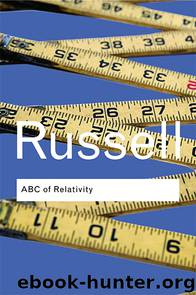ABC of Relativity by Russell Bertrand

Author:Russell, Bertrand
Language: eng
Format: epub
Tags: Humanities
Publisher: Taylor & Francis
Published: 2009-03-02T05:00:00+00:00
8
EINSTEIN’S LAW OF GRAVITATION
Before tackling Einstein’s law, it is as well to convince ourselves, on logical grounds, that Newton’s law of gravitation cannot be quite right.
Newton said that between any two particles of matter there is a force which is proportional to the product of their masses and inversely proportional to the square of their distance. That is to say, ignoring for the present the question of mass, if there is a certain attraction when the particles are a mile apart, there will be a quarter as much attraction when they are two miles apart, a ninth as much when they are three miles apart, and so on: the attraction diminishes much faster than the distance increases. Now, of course, Newton, when he spoke of the distance, meant the distance at a given time: he thought there could be no ambiguity about time. But we have seen that this was a mistake. What one observer judges to be the same moment on the earth and the sun, another will judge to be two different moments. ‘Distance at a given moment’ is therefore a subjective conception, which can hardly enter into a cosmic law. Of course, we could make our law unambiguous by saying that we are going to estimate times as they are estimated by Greenwich Observatory. But we can hardly believe that the accidental circumstances of the earth deserve to be taken so seriously. And the estimate of distance, also, will vary for different observers. We cannot therefore allow that Newton’s form of the law of gravitation can be quite correct, since it will give different results according to which of many equally legitimate conventions we adopt. This is as absurd as it would be if the question whether one person had murdered another were to depend upon whether they were described by their first names or their surnames. It is obvious that physical laws must be the same whether distances are measured in miles or in kilometres, and we are concerned with what is essentially only an extension of the same principle.
Our measurements are conventional to an even greater extent than is admitted by the special theory of relativity. Moreover, every measurement is a physical process carried out with physical material; the result is certainly an experimental datum, but may not be susceptible of the simple interpretation which we ordinarily assign to it. We are, therefore, not going to assume to begin with that we know how to measure anything. We assume that there is a certain physical quantity called ‘interval’, which is a relation between two events that are not widely separated; but we do not assume in advance that we know how to measure it, beyond taking it for granted that it is given by some generalisation of the theorem of Pythagoras such as we spoke of in the preceding chapter.
We do assume, however, that events have an order, and that this order is four-dimensional. We assume, that is to say, that we know what we
Download
This site does not store any files on its server. We only index and link to content provided by other sites. Please contact the content providers to delete copyright contents if any and email us, we'll remove relevant links or contents immediately.
The Complete Stick Figure Physics Tutorials by Allen Sarah(7333)
Secrets of Antigravity Propulsion: Tesla, UFOs, and Classified Aerospace Technology by Ph.D. Paul A. Laviolette(5330)
Thing Explainer by Randall Munroe(3904)
The River of Consciousness by Oliver Sacks(3568)
The Order of Time by Carlo Rovelli(3161)
How To by Randall Munroe(3074)
A Brief History of Time by Stephen Hawking(2990)
I Live in the Future & Here's How It Works by Nick Bilton(2957)
What If?: Serious Scientific Answers to Absurd Hypothetical Questions by Randall Munroe(2667)
The Great Unknown by Marcus du Sautoy(2661)
Midnight in Chernobyl by Adam Higginbotham(2514)
Blockchain: Ultimate Step By Step Guide To Understanding Blockchain Technology, Bitcoin Creation, and the future of Money (Novice to Expert) by Keizer Söze(2465)
Networks: An Introduction by Newman Mark(2382)
The Meaning of it All by Richard Feynman(2317)
Easy Electronics by Charles Platt(2303)
The Tao of Physics by Fritjof Capra(2247)
Midnight in Chernobyl: The Untold Story of the World's Greatest Nuclear Disaster by Adam Higginbotham(2195)
Introducing Relativity by Bruce Bassett(2097)
When by Daniel H Pink(2097)
